Students at Life Learning Academy are disconnected – literally and figuratively. Many of the students live on campus, located on Treasure Island in the San Francisco Bay. Also, students arrive after experiencing life traumas, often involving the juvenile justice system, and not finding success in traditional school settings.
Kevin Hicks arrived at Life Learning Academy with his own unique trajectory, including growing food at a commune in the foothills of the Rocky Mountains, founding a rowing studio gym, and working as laboratory scientist at the United States Department of Agriculture.
The common denominator between students and teacher? According to Kevin, meaningful connections, worldly lived experiences, and adventure — the same components of a Fund for Teachers fellowship.
Last summer with a $5,000 Fund for Teachers grant, Kevin participated in the Marine Conservation program hosted by Global Vision International in Puerto Morelos, Mexico, to support the management and conservation of the Mesoamerican Barrier Reef. Working alongside national and international non-profits and government organizations, Kevin collected data, participated in coral nursery and management and joined beach clean-ups in the Mexico Caribbean Marine Biosphere Reserve, which is one of the largest ecosystems globally, and the largest national marine biosphere reserve in the Caribbean.
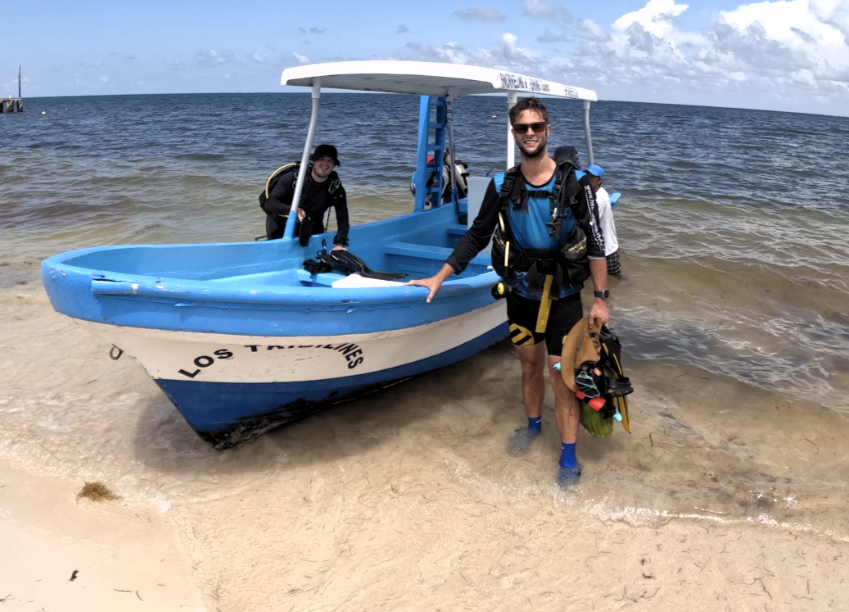
Afterwards, he studied Spanish with a tutor in Quintana Roo, improving fluency to better teach one-third of his students who are Spanish speaking.
“I got to see ‘Science as a human endeavor,’” said Kevin. “As humans, we have limited capacity. It made most sense to train us to be able to identify selected target species [such as sea turtles]. This way we focused on specific species that provide crucial data.”
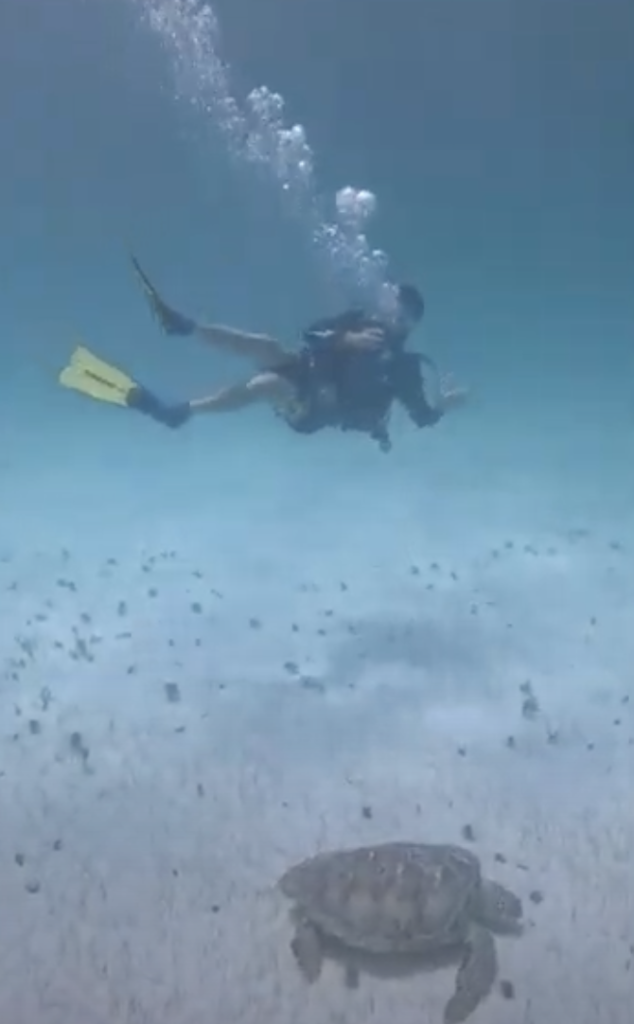
Kevin relies on a similar targeted approach when teaching his “Earth Optimism in Action” ecology class, focusing on specific issues that provide opportunities for collaboration and change.
“My students choose a local environmental issue for which I supply 1-2 resources for them to contact for more information,” explained Kevin. “As the name of the class implies, they are empowered to take action and reach out to local organizations for more information. Their final project will be an ‘Action Plan’ with the help of the local agency to address the issue at hand. My fellowship will be used as my example for their final project.”
Through this class (and his fellowship), Kevin models more than environmental stewardship and hands-on science. He exemplifies for his students Life in Action.
“As an educator, it is my responsibility to be a role model, and I would like to be a role model of a global citizen who takes action in the world for the things that I care about,” he said. “I deeply care about our natural environment, and particularly the oceans’ health. I want to show my students, by my actions not just my words, that their actions matter.”
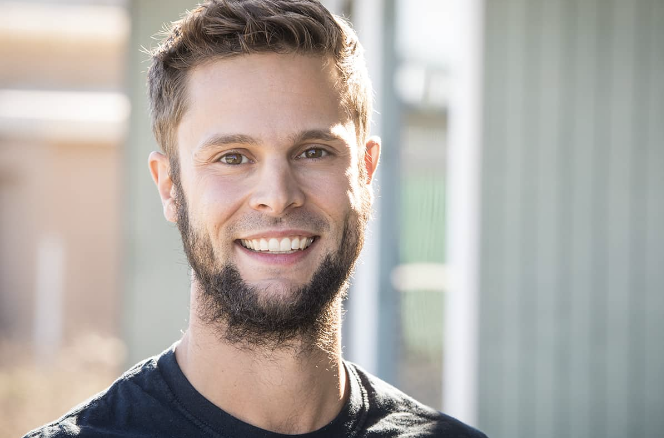
Kevin Hicks became a teacher through the US National Science Foundation’s Robert Noyce Teacher Scholarship Program. He also serves as director of education and first mate for Sea Valor, Inc., a nonprofit dedicated to improving life quality for Veterans, First Responders, those with PTSD and families affected by suicide.
Fund for Teachers, one of the nation’s leading organizations supporting preK-12 educators, is proud to announce its 2025 grant recipients. This summer, 357 teachers will leverage $1.625 million into experiential learning in 79 countries on 6 continents.
These educators comprise Fund for Teachers’ 25th cohort of FFT Fellows. Since 2001, Fund for Teachers has invested $39 million in 10,225 public, private and charter school teachers from across the United States.
Fund for Teachers annually invites teachers to propose solutions that address learning gaps for themselves and their students. Teachers are trusted with the freedom to determine what and where they want to learn and, after a thorough review process, individual teachers are awarded up to $5,000 and teams of two or more up to $10,000 to pursue customized professional development during the summer.
Fund for Teachers annually invites teachers to propose solutions that address learning gaps for themselves and their students. Teachers are trusted with the freedom to determine what and where they want to learn and, after a thorough review process, individual teachers are awarded up to $5,000 and teams of two or more up to $10,000 to pursue customized professional development during the summer.
“Teachers are at the heart of shaping not only students’ academic trajectories, but often also their social and emotional well-being,” said Karen Eckhoff, Executive Director. “Fund for Teachers believes this high calling merits validation and support, which we provide by funding fellowships that ultimately inspire teachers’ enthusiasm for student engagement and extend their longevity in the profession.”
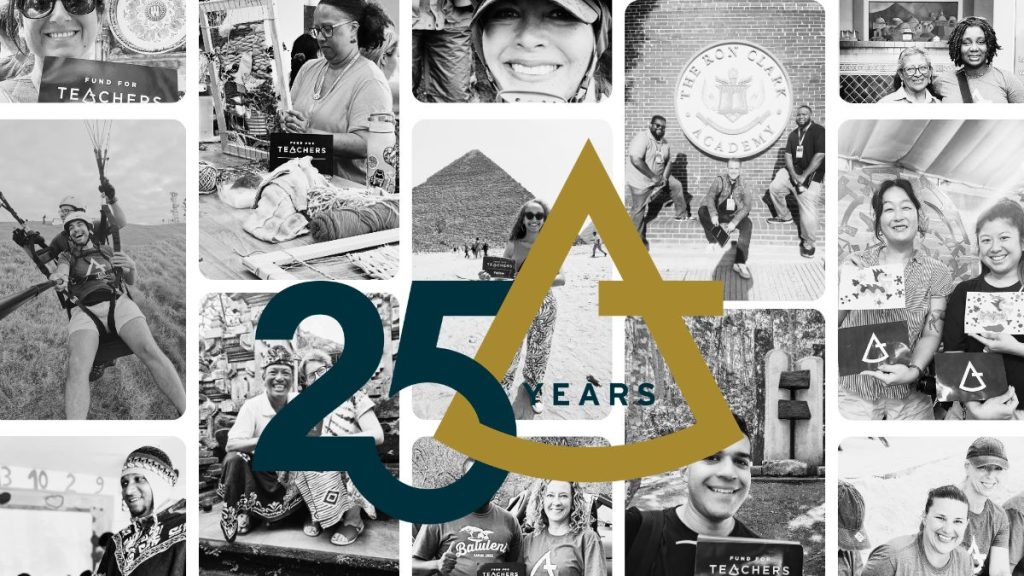
Once upon a time, an elementary school librarian became a Fund for Teachers Fellow, and her fairy tale dreams became a reality. It really did feel like a whirlwind fairy tale. Back in January of 2023, a friend of mine reached out to me about working together on a FFT grant. I was hesitant at first, because life felt very busy at the time, but after only a little convincing I agreed. However, the application’s due date was around the corner, so we got to work right away!
Hailey Wansick and I are both librarians, but she is a librarian at a high school, and I’m at an elementary school. We decided on fairy tales, because fairy tales and their lessons are for everyone. They have spanned hundreds of years, and they continue to enchant generations as retellings and fractured fairy tales are consistently being published today. After some research, we decided to focus on England, Germany, and France. We wanted to create a deeper understanding of fairy tale origins and their importance, promote excitement for and interest in reading, and enhance our library collections. We wanted to learn more about fairy tale pioneers like Madame d’Aulnoy, Charles Perrault, and the Brothers Grimm. When I got the email that said our proposal had been selected, and I was officially a Fellow, I ran to my principal’s office with tears in my eyes!
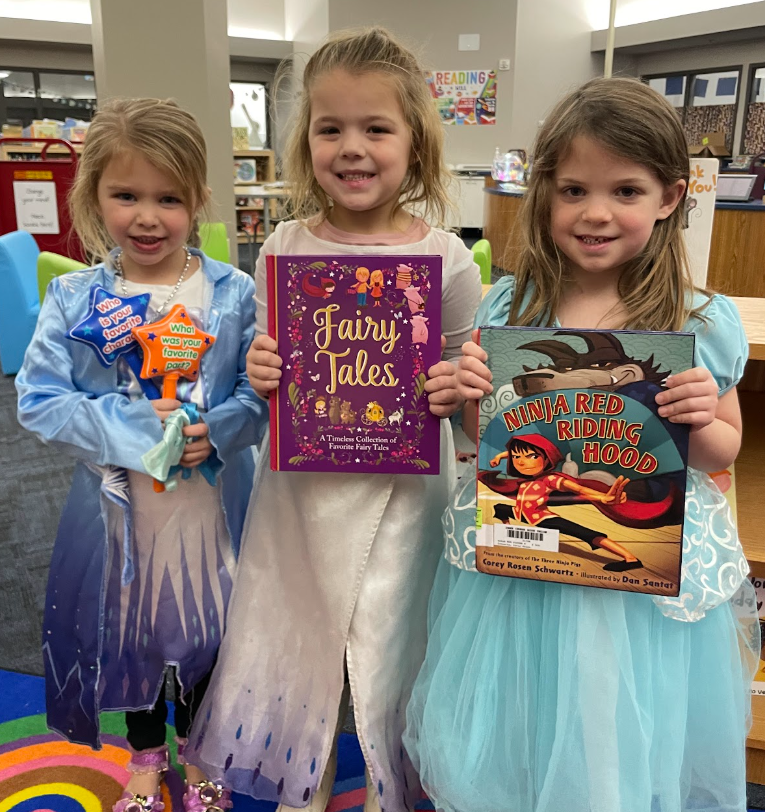
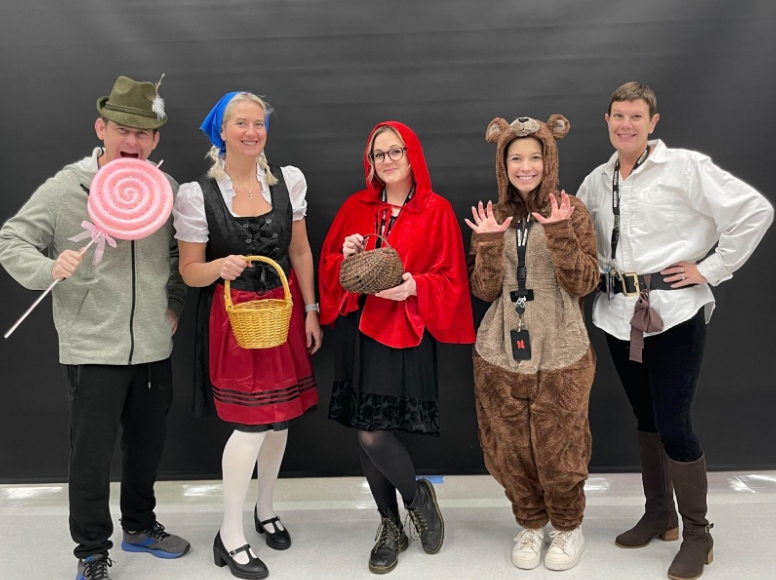
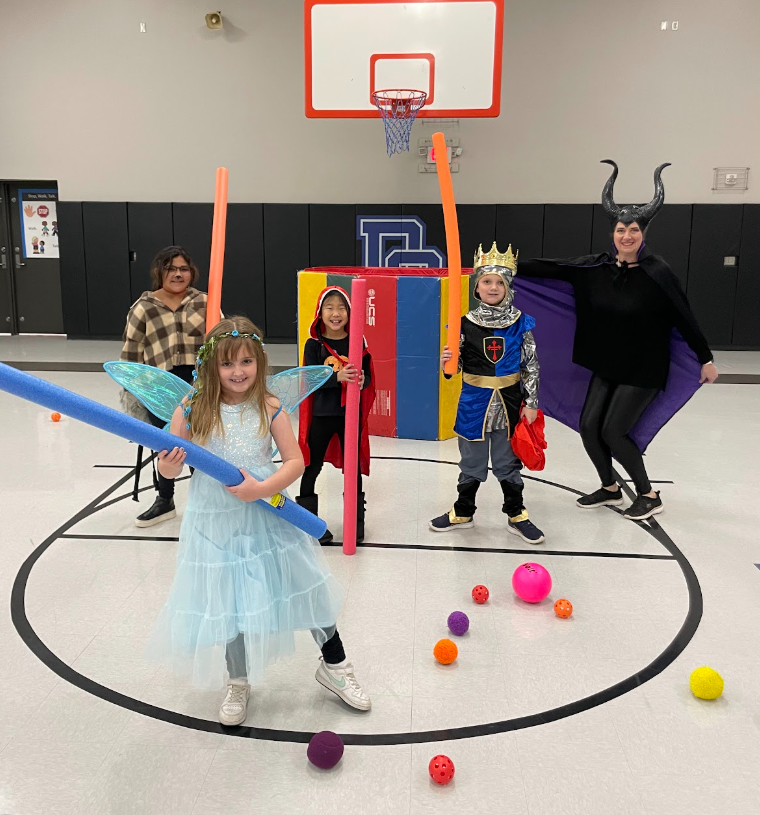
A few months later, Hailey and I flew into France, ready to start our adventure. Over the following two weeks, we traveled from France to Germany and then to England. We walked the streets of Paris and the Gardens of Versailles. We visited towns along the Fairy Tale Route in Germany. One of our favorite stops was GRIMMWELT Kassel in Kassel, Germany. GRIMMWELT Kassel is a Brothers Grimm museum. We learned so much about the Brothers Grimm, their inspirations, and their life works. Our last stop was England. Before the trip, I had been in contact with the University of Oxford’s Bodleian Libraries as well as the British Library. We were able to go through the process of acquiring library cards and gained access to their special collections. Being able to see and touch rare fairy tale books was this librarian’s dream come true! My fellowship made me realize I have so much more to learn about fairy tales! I still feel this way. There is such a rich and extensive history surrounding fairy tales.
After I got back home it was time to work on bringing the magic to my students. Fairy Tale Week was born. I collaborated with my specials team on making Fairy Tale Week a reality. Students would have fairy tale-themed lessons in all of their specials classes: music, PE, art, STEM, and library. We would have a dress-up day on the Friday of that week, because who doesn’t want to dress up like a fairy tale character or creature? In November 2023 we had our first Fairy Tale Week, and it was a magical success. Students drew castles, dragons, and king and queen portraits. They played fairy tale games, and created their own fractured fairy tales. They participated in a musical storytelling and a Disney sing-a-long. They also competed in fairy tale STEM-related challenges.
The week had been like a dream, but as I read stories to all of my classes that week, I realized many of my students were unfamiliar with the original fairy tales. To address this gap, this year I spent more time reading classic fairy tales to all of my students in preparation for Fairy Tale Week. Our second annual Fairy Tale Week was in January 2025, and it was once again filled with fairy tale-themed lessons in all of the specials classes. Fairy Tale Friday was especially fun! Classes gathered in the gym for enrichment during specials, where they heard the story of Rumplestiltskin, played a kingdom-defending game, and showed off their wonderful costumes. Both Fairy Tale Weeks wouldn’t have been as magical without my team. With my whole team on board, we were able to create a special week for all of our students! Recently, I have had teachers express a desire to have additional grades collaborate with us in the future. It will be interesting to see how Fairy Tale Week evolves.
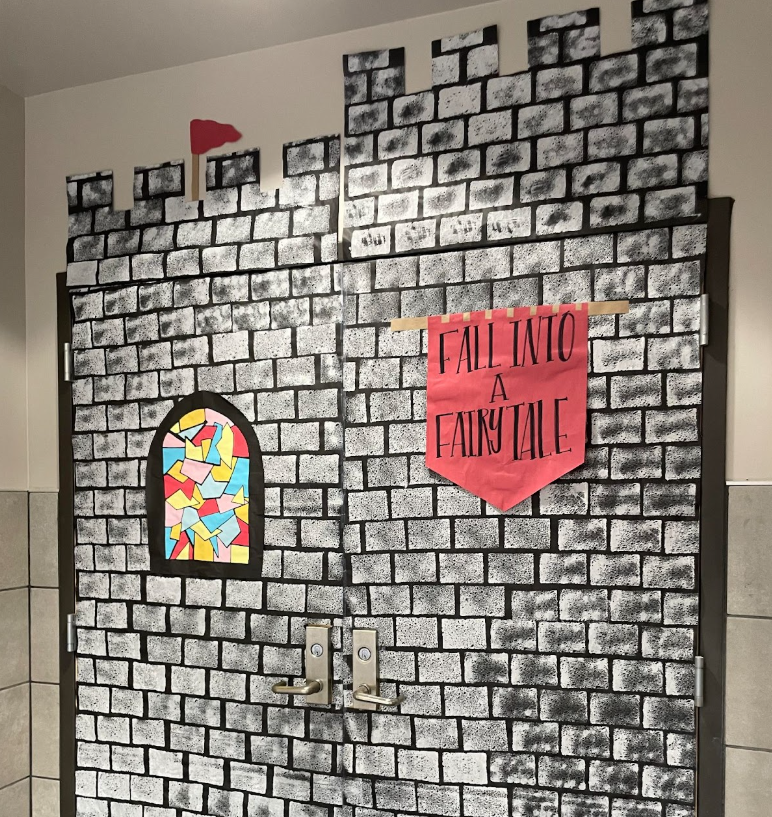
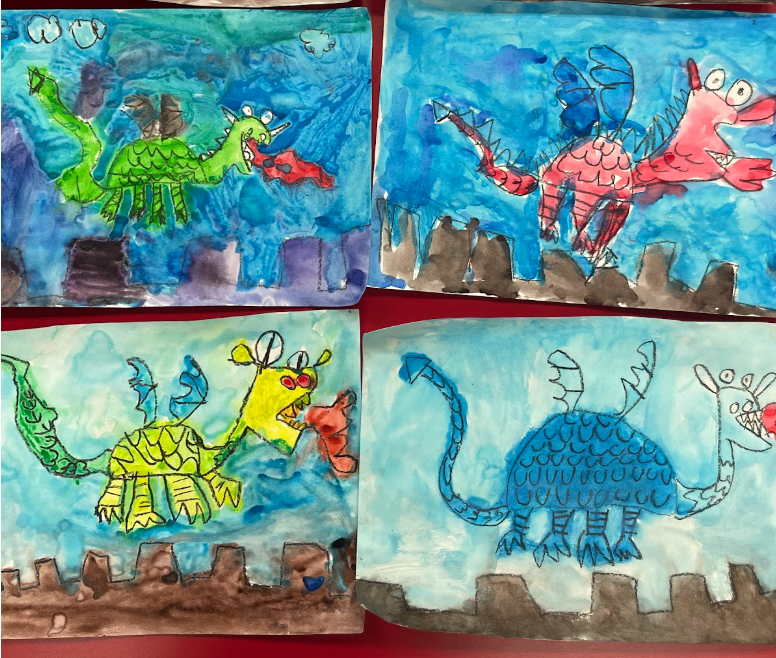
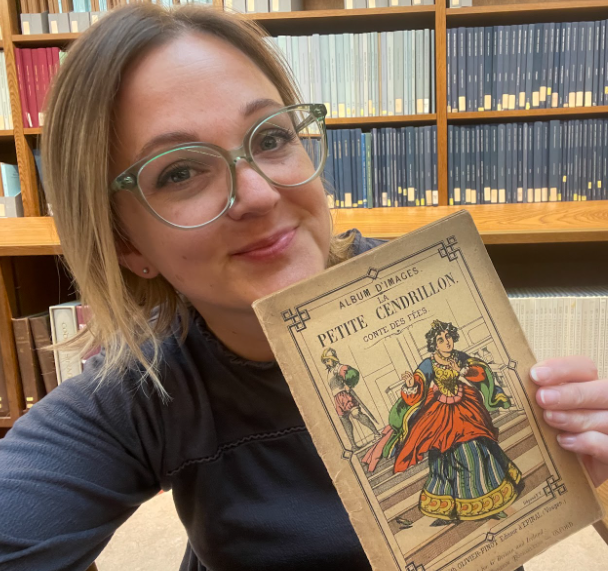
I’m so grateful to have been awarded this grant and to be able to call myself a Fund for Teachers Fellow. This experience has created in me a lifelong interest in fairy tales and a desire to share them with my students. I was able to present, along with Hailey Wansick, about our fellowship at the 2024 Oklahoma Library Association conference as well as during an Oklahoma School Librarians (OKSL) Learning Module over the summer. It was an honor to share with others about this special professional development opportunity and encourage them to apply! People often ask me what my favorite fairy tale is, and I have such a difficult time answering this question, because I know I have so many more fairy tales to read and discover! However, if I have to choose, Little Red Riding Hood is a forever favorite. National Tell a Fairy Tale Day is on February 26th, and I encourage everyone to take this opportunity to share with others a tale as old as time!
The town of Roseburg, Oregon has a few notable distinctions – the subject of the Johnny Cash song “Lumberjack” and home to a pack of feral angora goats that predicted weather in the 1980s – but a diverse demographic is not among them. The county seat is 91% white and the students at Roseburg High School mirror that statistic. In this homogeneous milieu, social studies teacher (and Roseburg native) Ashley Painter was tasked with crafting Music History and Native American Studies courses, she used Fund for Teachers to orchestrate it.
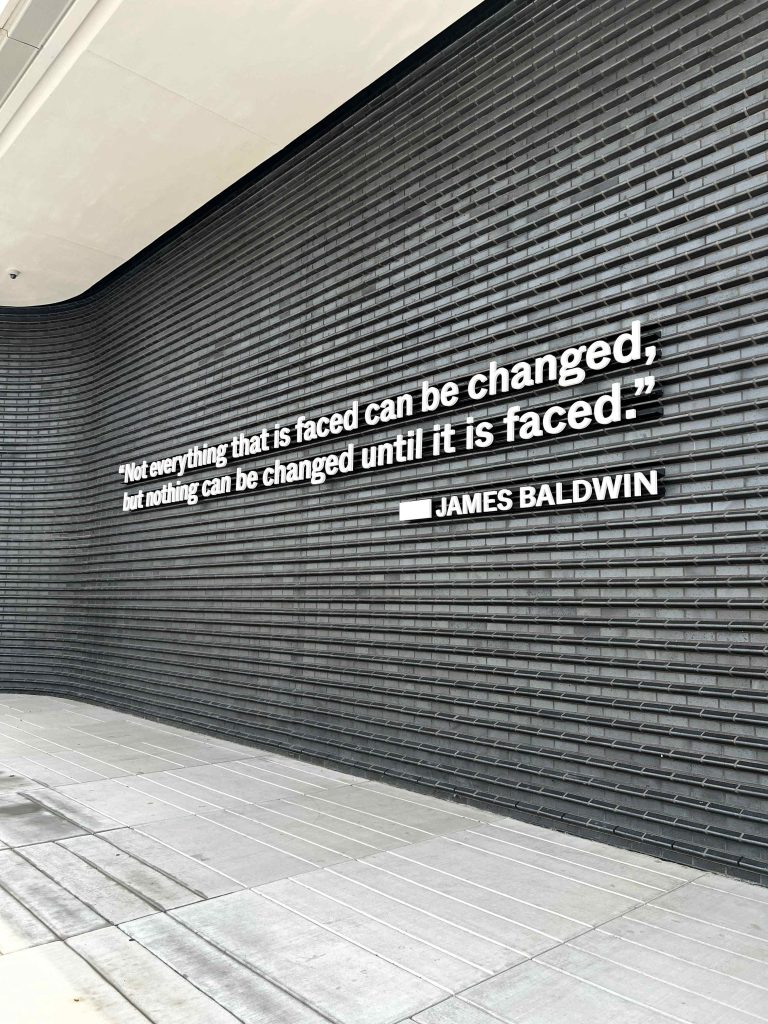

“My $5,000 grant funded a road-trip focusing on historic sites in America’s South and Midwest that highlight Civil Rights, Native American, and musical history,” said Ashley. “While my motivation for this fellowship came from a passionate and emotional appreciation for these cultures and historical content areas, there are also several new standards in Oregon that this project helped several courses meet.”
On the road, she toured the Greenwood Rising Museum & Black Wall Street History Center in Tulsa when documenting country music. She walked around Whitney Plantation and Congo Square while seeking out jazz history in New Orleans.
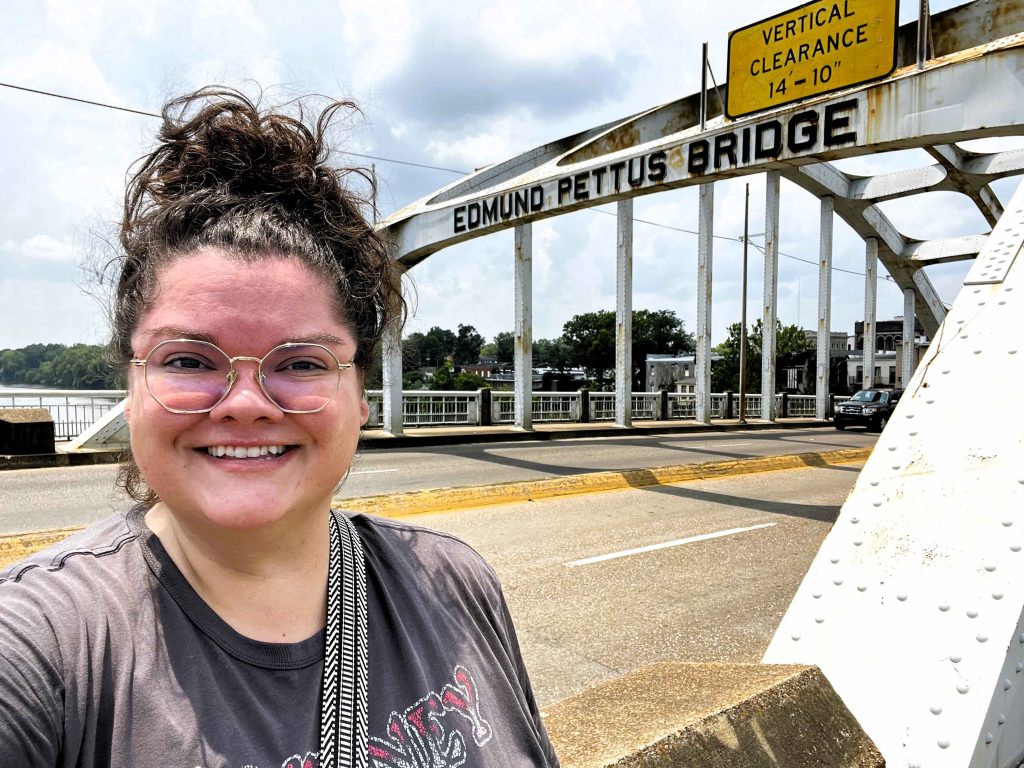
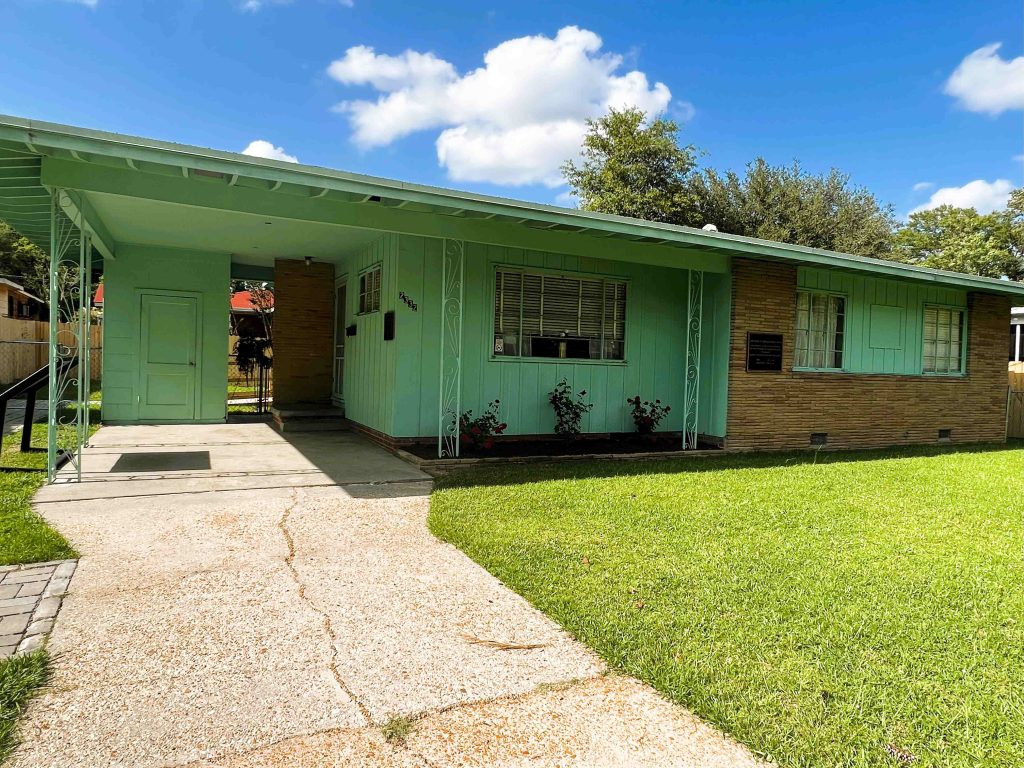

She crossed the Alabama River on the Edmund Pettus Bridge and toured the National Memorial for Peace and Justice. She stopped at the Mississippi Civil Rights Museum and Medgar Evers’ home while following the Mississippi Blues Trail and visited the Delta Blues Museum and the legendary Crossroads in Clarksdale, Mississippi.
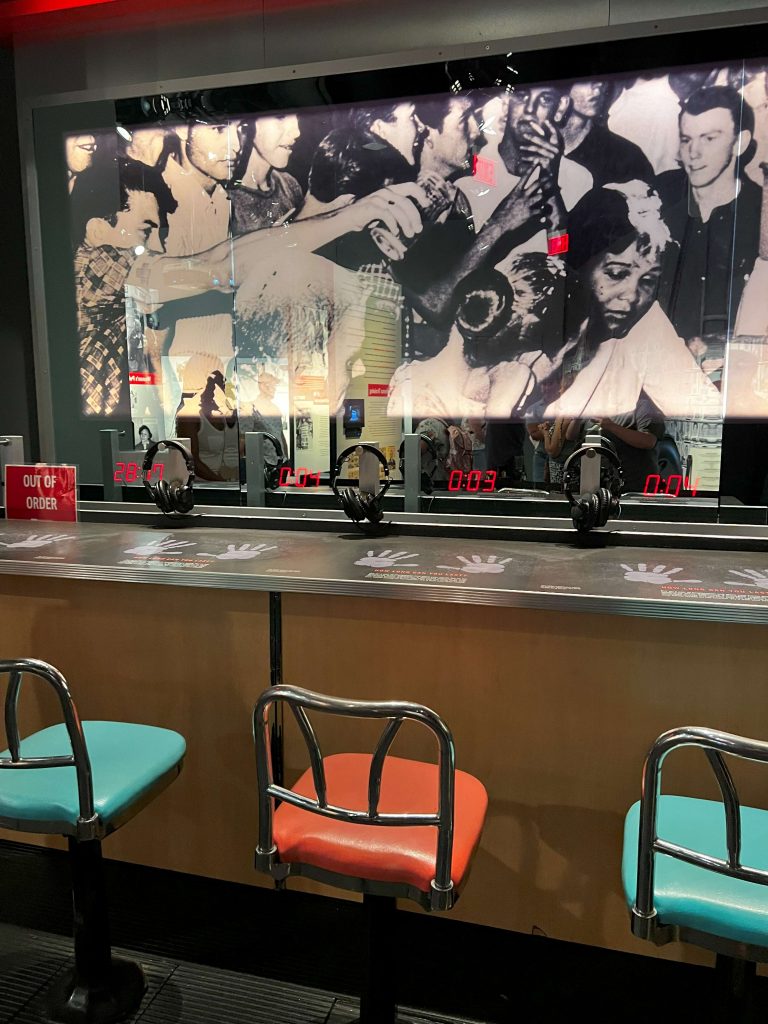
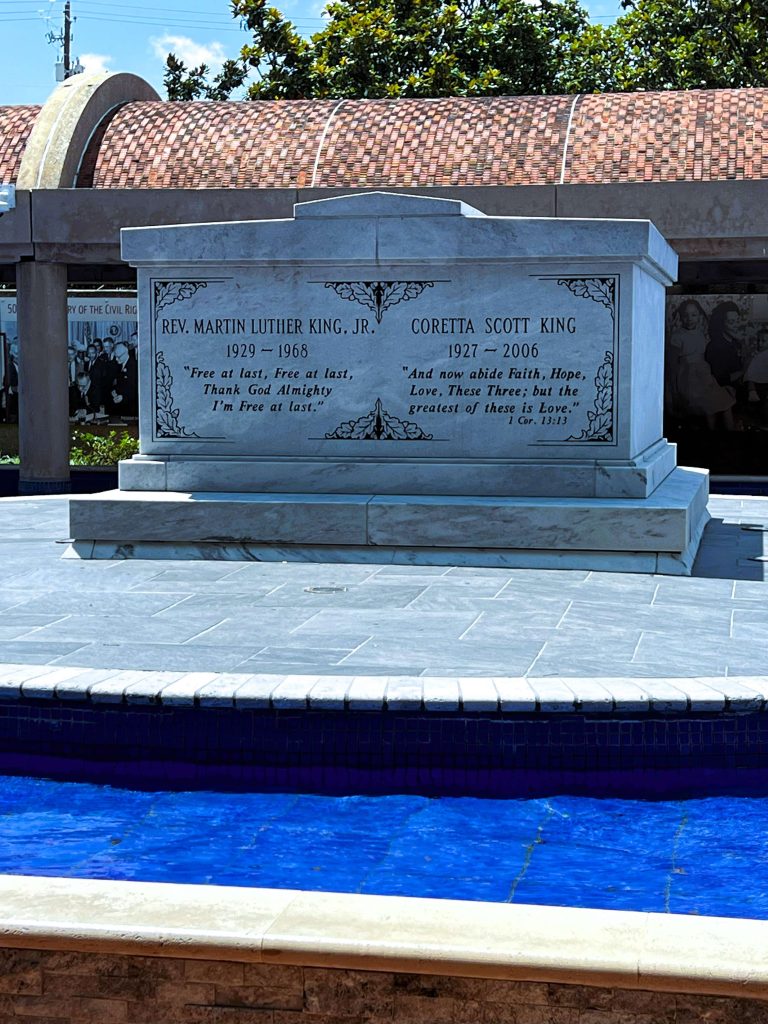
In Georgia, she sat at a lunch counter sit-in simulator at Atlanta’s Museum for Civil and Human Rights when researching the roots of rock and roll. And in Tennessee, she stood reverently outside the Lorraine Hotel after touring the Blues Hall of Fame and Sun Records (recording studio of such icons as BB King and Elvis Presley) in Memphis before taking the stage at Nashville’s Ryman Auditorium and making a pilgrimage to the Woolworth’s on 5th.
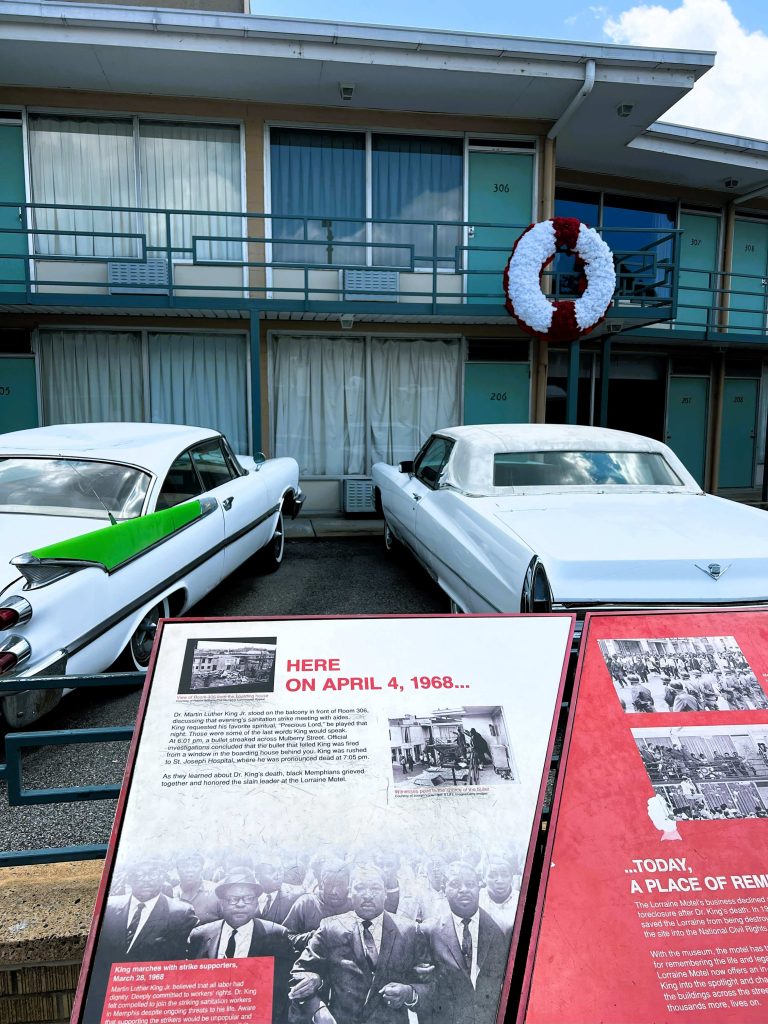
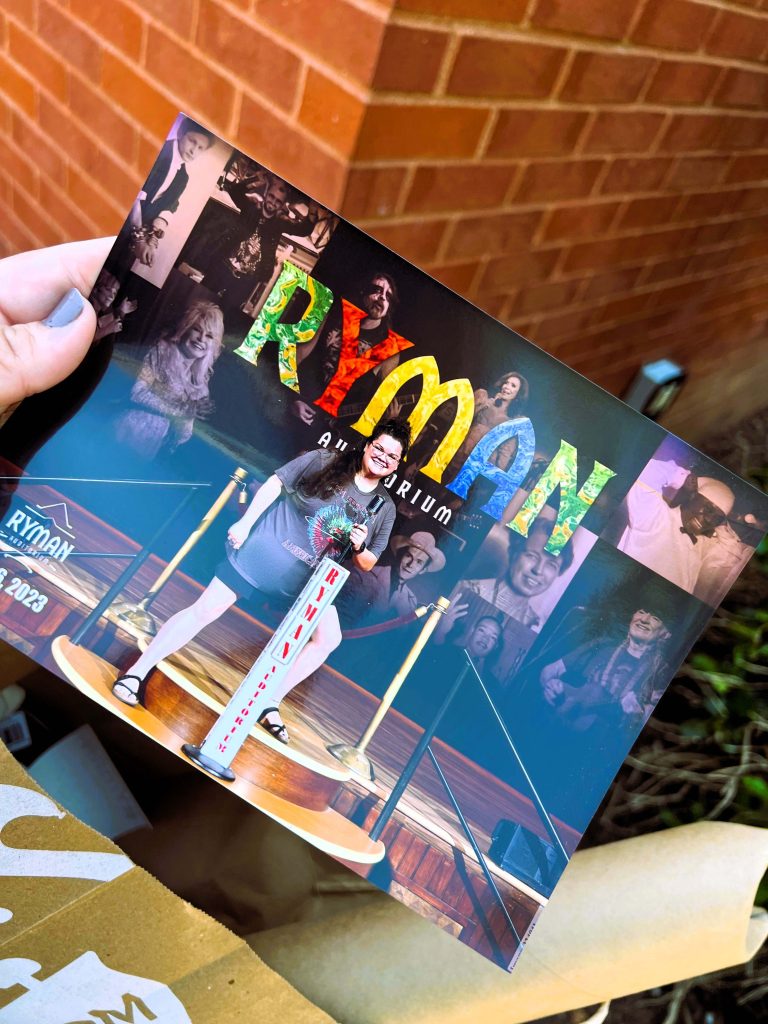

Ashley rounded out the odyssey with visits to The Museum at Bethel Woods and Max Yasgur’s Farm, the site of the 1969 Woodstock Music Festival, Cleveland’s Rock and Roll Hall of Fame and Museum; Detroit, the Home of Motown; and Chicago’s DuSable Black History Museum, Ida B. Wells House, Monument to the Great Northern Migration, and Chess Records.
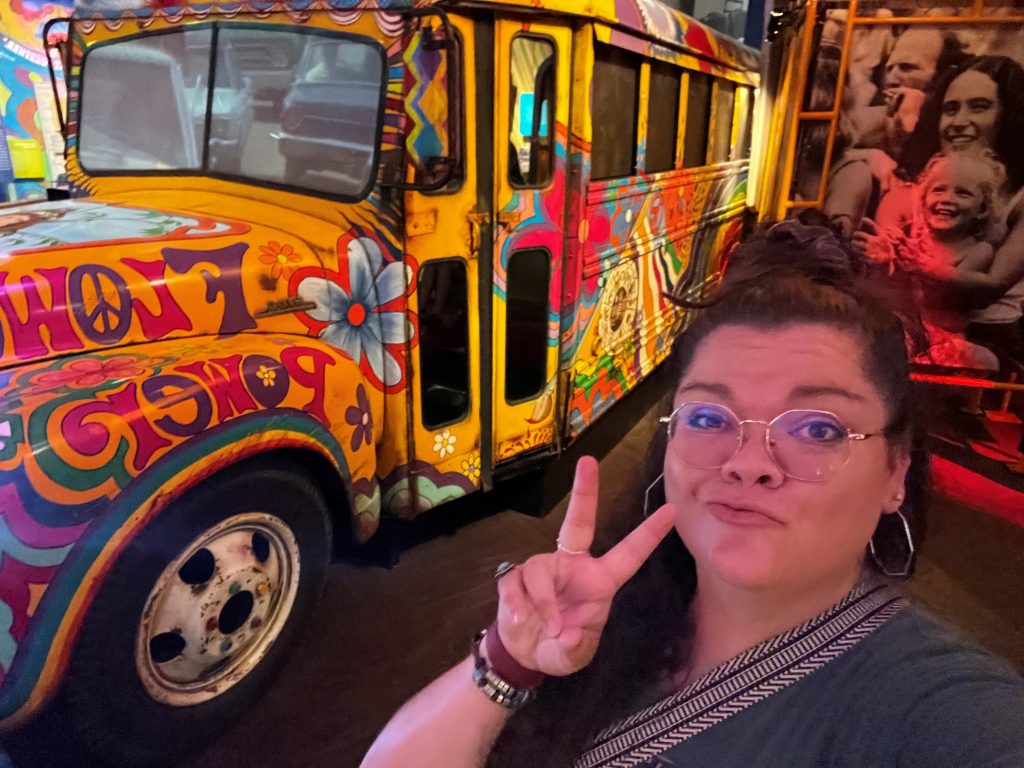
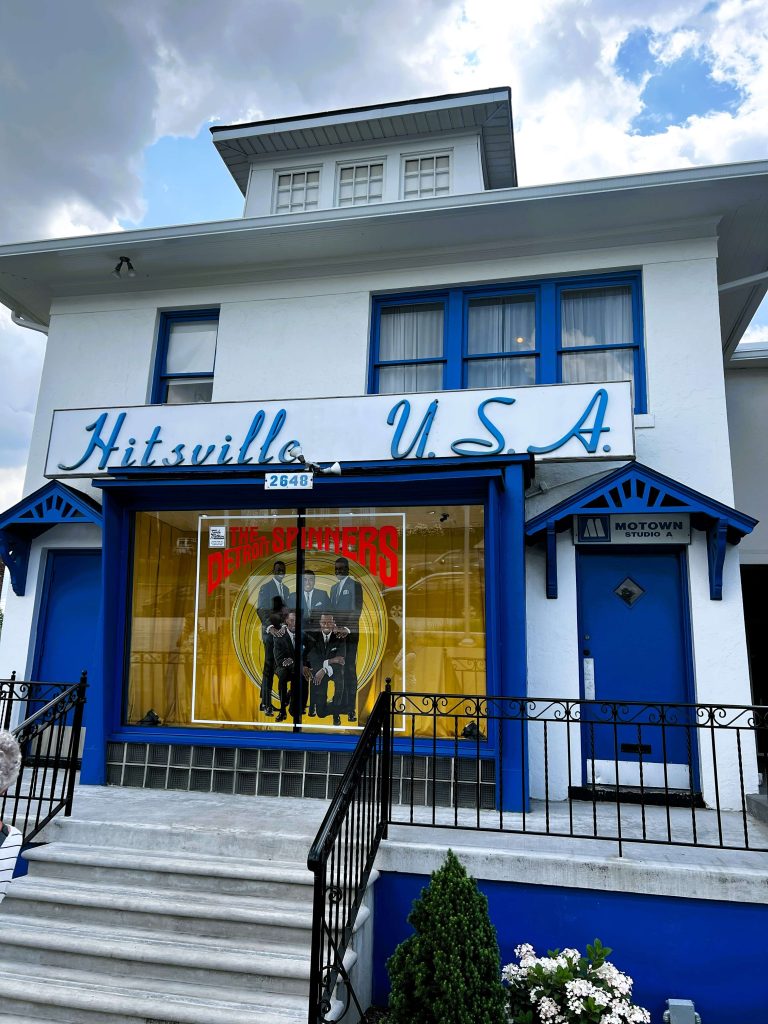
Artifacts and experiences gathered on her 10,000 mile/six-week journey now inform the majority of her Music History course, which focuses on US history from the mid-1800s through the 1990s and how music reflected and influenced current events of the day. So far this semester, students have been decoding spirituals. Ashley learned about Underground Railroad codes embedded in quilts and spirituals at Slave Haven in Memphis, where she sang “Swing Low Sweet Chariot” with the other visitors, and was led to a small compartment under the house where people seeking their freedom hid more than 150 years ago.
“I aim for my emotion and experience to be funneled through my teaching to inspire my students to move beyond being knowledgeable, and to work for change in how they treat others and inspire other people to do the same, to travel and move beyond our state that so few of them have left, to find interest in other cultures and histories, and to yearn for knowledge throughout their lives,” said Ashley. “I believe my example of being a life-long learner, an empathetic change-seeker, and a risk-taker through this fellowship encourages my students to do the same throughout their lives, as well.”
Three years ago, Ariana Sanders (Cincinnati) used a $5,000 Fund for Teachers grant to participate in the Witness Tree Institute’s immersive educator experience in Ghana, where she explored the impact of colonization, as well as how Africans protect their natural resources. Her goal was to inform the development of learning objectives and course modules for Ethnic Studies to be offered not just at her school, Wyoming High School, but to ALL of Ohio’s high school teachers.
“I cannot count the ways in which this fellowship was an influential time for me,” said Ariana. “It felt like an inspired experience literally from the second the plane landed — I felt more connected to my roots as a biracial person. The Witness Tree Program really allowed me to go into areas where it is NOT touristy, talk to many professors, participate in cultural activities (food, dancing, games, etc.) It is hard to put into words what that means or how much I see that impacting my soft skills — understanding others, appreciating differences…we all clearly need more of that!”
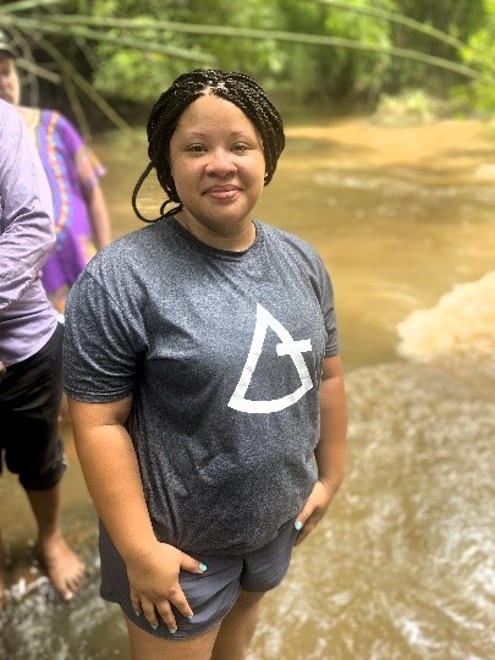
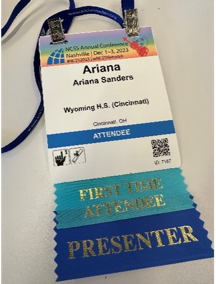
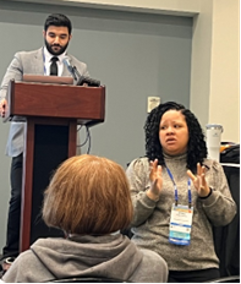
Caption: Standing in Slave River, where captured men, women and children slaves bathed for the last time before they went to the auction; Ariana’s conference nametag and presentation session.
That connection and cultural immersion informed learning standards and curriculum for a new official course offering in the Ohio Social Studies program called Religion, Gender, and Ethnic Studies, which Ariana presented at the National Council of Social Studies’ national conference.
Additionally, Ariana sits on the advisory board for Boston University’s Teaching Africa Teacher (TAT) Certificate Program, which supports pre-service and in-service K-12 teachers and higher education instructors interested in engaging with Africa in their classrooms. As part of this opportunity, Ariana crafted an additional curriculum titled W.E.B. DuBois & Ghana: As told through 3 primary sources – which you can access here.
“I’ve kept up with colleagues from my fellowship in Ghana, so those relationships, as well as peers through the TAT board, give me a space to advance higher education African studies and be in touch with people who are also working to ensure Africa is represented in more social studies classes. I feel like I am the biggest cheerleader for Fund for Teachers.”
W.E.B. DuBois said, “It is the trained, living human soul, cultivated and strengthened by long study and thought, that breathes the real breath of life into boys and girls and makes them human, whether they be black or white, Greek, Russian or American.” He would be proud of the impact Ariana is making, as are we.
Half-way through the summer means roughly 50% of our 2024 FFT Fellows have embarked on their self-designed fellowships. Their images and insights, make us even more excited for the rest of the summer…
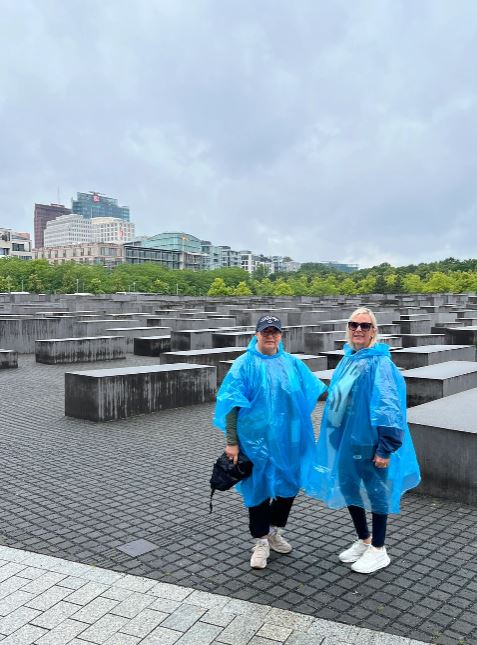
“We dared to dream of a self-guided and personally driven professional development opportunity for the summer of 2024 and Fund for Teachers made our dream come true. Our time here not only broadened our knowledge but also deepened our appreciation for the resilience of the human spirit. Our hearts are full, our minds enriched, and our spirits uplifted by the profound experiences we have had.”
Tammie Crosby & Vilma Martinez (Rosenberg, TX) used a $10,000 grant to explore in Germany locations tied to the Holocaust to gain a first-hand understanding of its impact and transform lessons that will empower students to foster empathy and inspire commitment to building a better future.
Jackie Du and Alex Whedbee (Brooklyn, NY) used a $10,000 grant to explore fiber arts of Vietnam through visits to various cultural institutions and by participating in a variety of textile workshops led by indigenous communities and artists with disabilities to learn how traditional and modern techniques disrupt stereotypes and to introduce differentiated, sustainable artmaking to students.
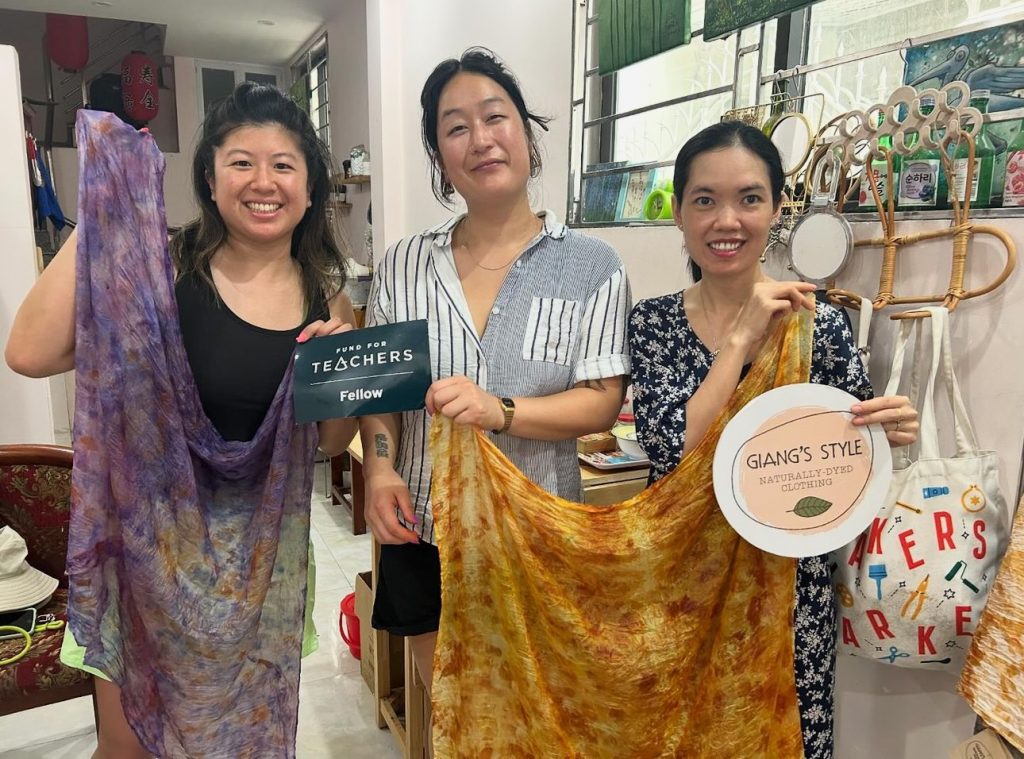
“Natural Bundle Dyeing incorporating natural materials to dye 100% silk. Giang (our teacher) showed us how to use onion skin (rust/brown), hibiscus (pink/purple), butterfly pea blossoms (blue), annatto powder (orange), and turmeric (yellow) to create the color palette and design we wanted. Such a wonderful experience! Thank you! We are excited to bring this into our classroom for our students!”
Lindsay Berk (San Francisco, CA) used a $5,000 grant to attend the Morpho Institute Educator Academy in the Peruvian Amazon and Machu Picchu Extension to participate in inquiry based professional development and to investigate how international scientists and local indigenous communities have partnered to preserve the rich biodiversity of the area, and to open students’ minds as to why they should care.
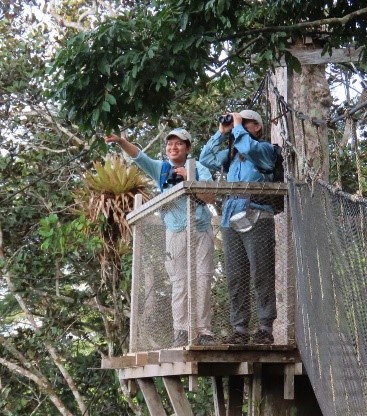
“I just wrapped up a jam-packed, enriching and eye-opening professional development experience in the Peruvian Amazon. From experiencing awe and wonder firsthand to conducting inquiry explorations, to deeply connecting with a community actively protecting the rainforest, [the fellowship] went beyond my expectations.”
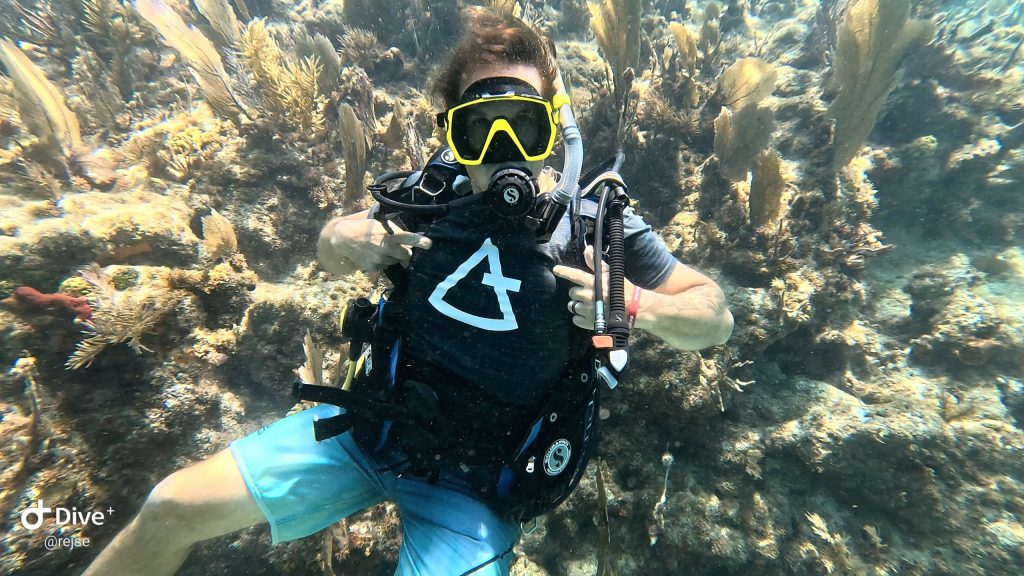
RJ Christensen (Houston, TX) used a $1,000 Innovation Circle Grant to gather visual and analytic information from university research labs and coral reef dives in Florida to educate students on marine conservation, culminating in a large-scale community sculpture built by students that highlights the interconnectedness between endangered marine life and human well-being.
For decades, summer reading and school year syllabi have included The Great Gatsby, and James Sheridan’s AP English Literature class at Houston’s YES Prep East End Secondary is no exception. This spring, however, his personal experience with the text will far eclipse anything his students could Google related to the novel, the film starring Leonardo DiCaprio, or the Tony-award winning Broadway musical.
“I designed this fellowship because I want The Great Gatsby‘s world to have a conversation with the 2024 world of my students,” James explained. “I want them to feel the ways that the book and its often-doomed characters can connect with and reflect their own life experiences (and those of their families).”
Yes Prep East End Secondary is situated in the working-class East End neighborhood, in near-view of the city’s ship channel and industrial port — the busiest in the United States. It is an area rich in history from the founding of Houston to a vital role in the Texas Revolution. It is also crisscrossed with freight trains carrying goods from all over, often resulting in stopped trains. Some people claim that more trains stop here than anywhere else in the country! However, only a few miles away from their neighborhood are, figuratively, our Houston versions of West and East Egg, containing very wealthy communities, downtown arenas for Houston’s professional basketball and baseball teams, and a world-class museum district and medical center. In other words, James’s students navigate a complicated landscape of working-class realities as well as stunning wealth. Just like Nick Carraway and Jay Gatsby.
That landscape came to life in June, as James set off with his wife and two children to document the context and characters described in F. Scott Fitzgerald’s Great American Novel.
“Driving in through some dense traffic on a Tuesday morning, we recreated Nick and Gatsby’s famous drive into the city in Chapter 4, the drive featuring Gatsby’s tales of his life, his Montenegro medals, and Earl of Doncaster photo. Nick states, “Over the great bridge, with the sunlight through the girders making a constant flicker upon the moving cars, with the city rising up across the river in white heaps and sugar lumps all built with a wish out of non-olfactory money.” It is impossible to disagree with the transfixing nature of such an entrance to one of the greatest cities in the world! Many of the key scenes in the novel happen in New York City: Gatsby and Nick’s lunch with the gangster in Chapter 4 as well as the Chapter 7 Plaza Hotel showdown.”
During my fellowship, each day coincided with a chapter as best I could make it. For Part 1, we drove the length of Long Island, passing The Hamptons only a few days after President Biden fundraised there and a few weeks after the latest celebrity drunk driving scandal. At Montauk, where the bay meets the ocean, it was a perfect spot to reflect on the role of water in the novel and Nick’s final reflections on Gatsby and what it all meant. Instead of a green light, there is a stunning lighthouse commissioned by George Washington. Then, we toured the Gatsby-esque, Gatsby-era Oheka Castle , finding modern day concordances that would have delighted Gatsby! (If having a Taylor Swift video filmed at your mansion is not the height of social cache, I don’t know what is!)
Next, we explored Port Washington and Great Neck, models for the fictional East & West Egg, driving past glittering mansions that offered small glimpses of Manhasset Bay. Included in our journey was a pilgrimage to the home that Scott and Zelda rented in 1922 where he started writing the novel. Finally, we found a marvelous spot to get ice cream and watch the sunset over the water before driving over the Queensboro Bridge, just like Nick and Gatsby, into Manhattan before heading home.
“Driving through Great Neck, Long Island, we saw the roads that Scott and Zelda undoubtedly drove down in the 1920’s, with gorgeous skylines peeking out from behind mansions and dense trees. There was even a Gatsby Lane in the Kings Point neighborhood, but true to form, it was a false front: created as a marketing tool, no doubt, and not authentic to the time period. The views across the bay are all private ones or in parks that require proof of residence, very exclusive. And stopping at a diner for dinner, we saw myriad Gatsby references and maps that show off the Eggs (Gatsby and Nick’s West Egg = Great Neck, Kings Point; Daisy and Tom’s East Egg = Port Washington, Manor Haven, Sands Point).”
With new artifacts and insights, James intends to create content using a student-friendly Instagram account as well as QR codes for students to access after reading each chapter. The Instagram account is already receiving comments from people who know the world and location of the Gatsby story, adding further insight and authenticity to a living, relevant study of the novel. Ultimately, students will create videos and written reflections about essential questions and places in their own lives.
“I am grateful to Fund for Teachers for supporting this journey into the heart of the novel, the 1920’s, and all the modern-day concordances!” said James. “I feel a sharp sense of geography and place as well as numerous ways to link 2024 and 1922 because of this work…I will part with Fitzgerald’s closing sentence to the novel: “So we beat on, boats against the current, borne back ceaselessly into the past.” As Fitzgerald wisely knew, the pull of the past is always compelling; it is always part of what makes us human.
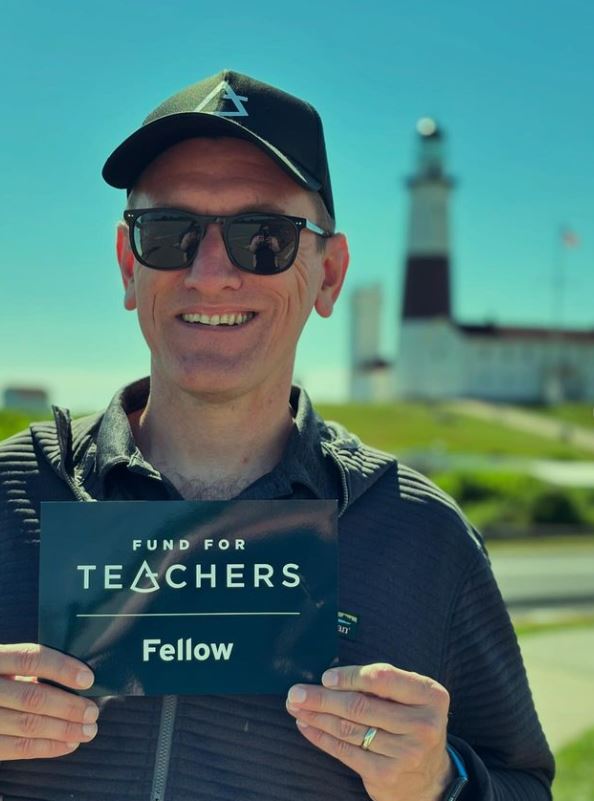
James T. Sheridan is an AP English Literature instructor and Course Facilitator at YES Prep East End Secondary School in Houston, Texas. He was a 2000 Houston Teach For America Corps Member whose 24-year teaching career has taken him from Houston to Philadelphia and back. He has been honored as a 2012 Kinder Award Winner for Excellence in Teaching, a Finalist for the 2015 Fishman Prize for Excellence in Teaching, and a 2015 Teach For America Alumni Award Winner for Excellence in Teaching.
For hundreds of teachers, today changes everything. Because today, Fund for Teachers’ 2024 grant application opens. Empowered by experiential learning fueled by $5,000 (for individuals) or $10,000 (for teams of two or more), our grant recipients are inspired to rethink their practice and reignite their passion for teaching, which consequently impacts their classrooms, school communities and careers for years to come.
PreK-12 teachers from across the country are invited to propose a summer fellowship that is:
Our application deadline is January 18, 2024, and members of the 2024 FFT Fellow cohort will be notified on April 4, 2024.
Are You Eligible? 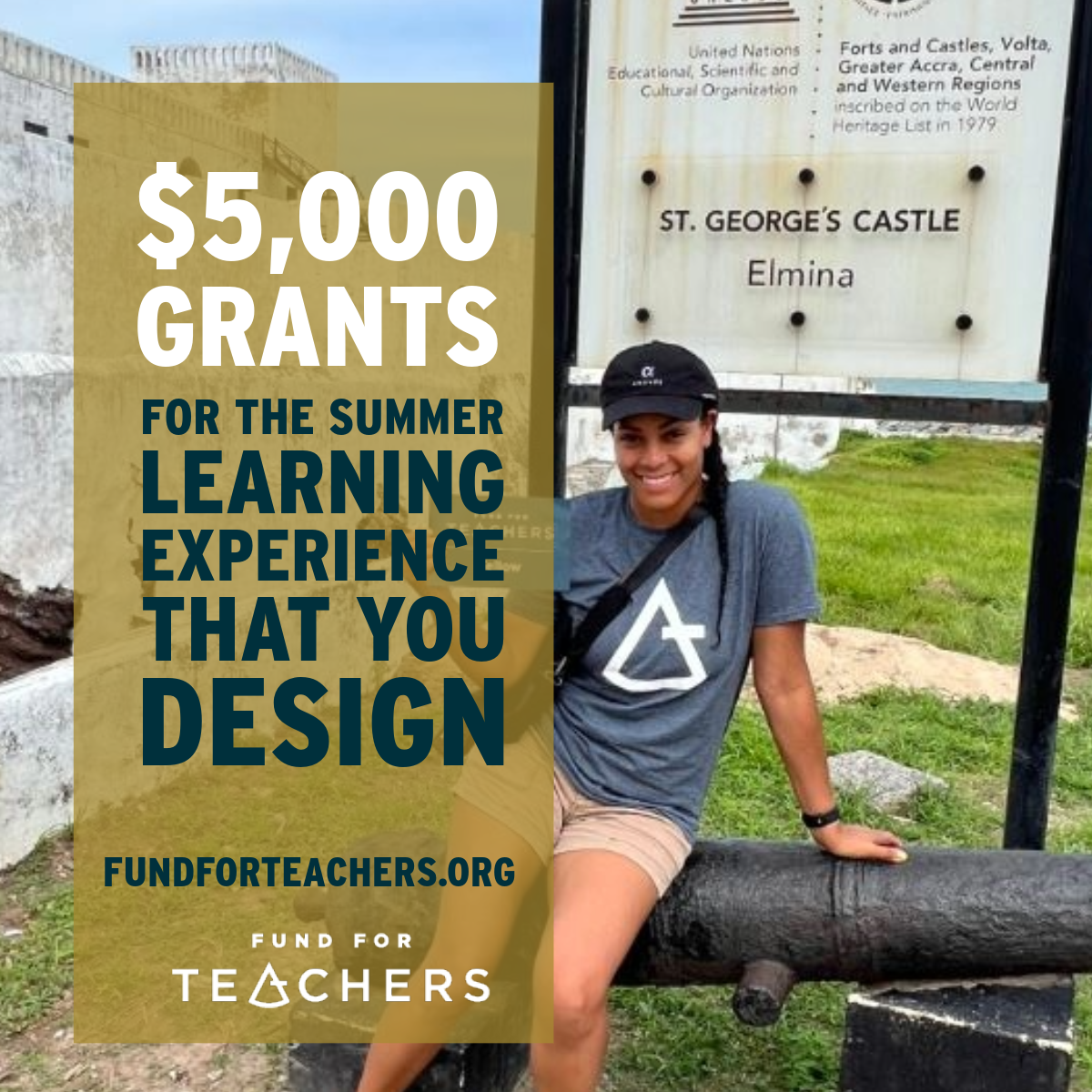
YES, if you:
What’s Your Re?
This year, we’re asking potential applicants to consider “What’s your Re-?” In other words, what could a Fund for Teachers grant help you accomplish?
During the next few months, Fund for Teachers will offer webinars and workshops designed to facilitate fellowship proposals that have the best chance of being awarded. (Watch our website for updates and registration links).
We also encourage applicants to take advantage of our Online Learning Center, which has links to the scoring criteria, grant writing tips, and a timeline for managing the process.
“Fund for Teachers is the country’s largest investor in teachers’ professional learning, with approximately 10,000 educators awarded $32,000,000 in grants for self-designed fellowships since 2001,” said Karen Eckhoff, executive director. “Now it’s time to add to our cohort of teacher leaders committed to their profession and their students’ learning.”
Today California’s state legislature will officially apologize to Japanese Americans sent to internment camps during World War II. This aspect of World War II is one many students don’t learn about during history classes, but one that many FFT Fellows seek to understand and share. Today, we share the learning of Timothy Nagaoka, whose grandfather fought for the United States in the European Theatre during the war.
[minti_divider style=”3″ icon=”” margin=”20px 0px 20px 0px”]
I teach Japanese as a foreign language to elementary and middle school students, many of whom come from immigrant families. Some families are from Central and South America, some from the Caribbean Islands, and others from Southeast Asia. I share this heritage. I grew up in Japan. My mother is sansei (third-generation Japanese American) from Hawaii; her father, a nisei (second-generation Japanese American), was one of many Japanese Americans on the island who enlisted after Pearl Harbor. He wanted to prove his loyalty to the country that had become very suspicious of his people, so he fought with other nisei from Hawaii in the 100th Infantry Battalion, which became one of the most decorated in military history.
Growing up, I heard my grandfather tell stories of fighting in Europe in World War II. Not until much did I learn of another battle fought by Japanese Americans on the mainland. It was not a battle of bombs and bullets, but a battle of patience and perseverance. Like my grandfather, who demostrated his patriotism by enlisting, many Japanese Americans proved their loyalty by enduring relocation to internment camps.
To fully understand and better teach this period of American history, I designed my Fund for Teachers fellowship to explore the Japanese American experience during World War II and – more specifically – the US government’s handling of these citizens.
I drove 3,500 miles through 8 Western States over 11 days to research 10 monuments and former internment sites. I also stopped at the Japanese American National Museum in Los Angeles (where I took a selfie with George Takai). An unplanned experience was attending the Annual Pilgrimage at Heart Mountain Relocation Center in Wyoming, where we honored those who who advocated, resisted and fought for Japanese Americans. It was this stop where I met former Secretary of Transportation Norman Mineta and Senator Alan Simpson.
Throughout my fellowship, I focused on two topics:
• What Japanese Americans endured throughout relocation, and,
• How relocation of the Japanese Americans is remembered today.
During the fellowship, I filmed interviews with former internees about their experiences, which I’m using as resources with students and colleagues. I am also designing two curricular units that teach about the Japanese American internment experience: one for Japanese language teachers that incorporates phrases and dialogues used in camps; and one for English Arts and Social Studies teachers who want to teach about the topic. Upon completion, I will offer workshops throughout Boston Public Schools and through local non-profit teacher training organizations.
In my classes, I’m using the knowledge and connections I gained through my fellowship to teach about the forced internment of Japanese Americans during the war. Previously, I’ve taught Japanese customs, traditions, history and culture, but I’d never considered teaching the Japanese American immigrant story. I now incorporate into my language lessons words and phrases, such as gaman (perserverance) and shikata ga nai (can’t be helped), that were often used by the Japanese Americans to describe their confinement. I’ve come to understand that by teaching my culture’s extraordinary circumstances, I can deepen connections with students whose lives reflect similar themes, old and new.
On January 2nd, 1945, restrictions preventing resettlement in the 100 mile Exclusion Zone along the West Coast was removed. I believe a strong democracy lies in not forgetting the past, especially not the mistakes. My fellowship researching the plight of tens of thousands Japanese Americans was humbling and allowed me to gain a more complete perspective of the American immigrant experience. I am using this perspective to better understand (and teach) my students from immigrant families themselves.
[minti_divider style=”1″ icon=”” margin=”20px 0px 20px 0px”]
Timothy Nagaoka teaches Japanese in six schools around the greater Boston area and has dedicated his career to creating opportunities for students and colleagues to connect with Japan. In recognition of his work, Timothy has received the John E. Thayer Award from the Japan Society of Boston, and the Henry L. Shattuck Public Service Award from the Boston Municipal
Research Bureau.
Read about another FFT Fellow’s experience researching life in and around Japanese Relocation Camps in Utah and Colorado here.
On Pearl Harbor Day, we remember the 2,403 people killed in the surprise attack by the Imperial Japanese Navy Air Service. The “date which will live in infamy” launched America’s entry into World War II; the bombings also resulted in the internment of 7,000 Japanese American citizens in relocation centers by order of President Franklin D. Roosevelt. Teaching the complexities of this time is complex in and of itself for Tim Barry. His students at Nathan Hale Middle School in Coventry, CT, fall within a wide range of ability levels.
“This drastic range creates difficulty when choosing and providing engaging and appropriate text for students of all abilities,” explained Tim. “Fortunately, with the broad scope of our World War II unit, we are able to provide high interest and appropriately leveled options so that all students may contribute and draw connections to classroom discussion and produce work that they can be proud of.”
But that unit lacked dialogue about the domestic impact of the war. Tim designed a Fund for Teachers fellowship fill that gap and, last summer, examined life in and around Japanese Relocation Camps in Utah and Colorado to help students:
[minti_divider style=”3″ icon=”” margin=”10px 0px 10px 0px”]

Last summer, I was fortunate to travel to Colorado and Utah to study Japanese Internment Camps as part of my Fund For Teachers fellowship. My intention was to supplement our current World War II unit with experiences from the home front to allow students to draw parallels in today’s climate of cultural bias. I want my students to draw inspiration my own curiosity and go out and explore the world. I want them to challenge what they know or think they know and I want them to be acutely aware of how history has a tendency to repeat itself.

Granada Relocation Center memorial
Trip Details: I spent nine days traveling from the Topaz Camp in Delta, Utah to the Moab Isolation Center in Moab, Utah and finally to Granada Relocation Center (Amache) in Granada, Colorado. In Delta, I was struck by the beautifully curated Topaz Museum which highlighted the blending of traditional Japanese culture with the easily recognizable American identity of the time. High school yearbooks, recounts of baseball games, and a letterman’s jackets sat side-by-side with instruments of the Japanese tea ceremony and watercolor paintings. Despite the dramatic civil rights violations perpetrated by the United States government, these proud people still created a sense of normalcy and everyday life. The message of their resilience is one that I hope will resonate with my students.

Pictured with Mr. Kitajima and Dr. Clark
The highlight of my trip was being able to connect with Denver University at their biennial open house at the Amache site in Colorado. There, I was introduced to Dr. Bonnie Clark who is the Project Director of the DU Amache Research Project. I was able to meet several former internees of the camp, including 87 year old, Mr. Ken Kitajima who was a resident of the camp from ages 12-15. My hope is that I can provide my students with a first hand account of what it was like to be of middle school age in a Relocation Camp. I plan to connect with Mr. Kitajima virtually to conduct interviews and provide insight into his experience. Perspective is one of the most important things I can offer to my students.
Middle school is a trying time and although the experiences of my students will be different than those of the past, the challenges will not be unique. My hope is that my journey will foster a sense of intellectual curiosity as my students create their own world view and tackle the test of growing up in an increasingly demanding world.
The digital world in which we live allows people to instantly access information and make snap decisions based on their own experiences and biases, yet we don’t often slow down to assess all sides of a story. Ultimately, I want my students to be willing to challenge what is accepted by society and greet people from all walks of life with an open mind.

The main thing that I was able to bring forth and offer to my students was perspective. In our curriculum, we dive deeply into the ideals in which the nation was built upon, the Constitution, Supreme Court cases, and World War II. Through my experiences at the Japanese Relocation Camps I can provide an alternative lens in which students can view historical events and how they correlate to our society today.
We broached difficult topics such as governmental policy, Supreme Court decision making, modern and historical biases, and comparing and contrasting Germany’s Nuremberg Laws and Executive Order 9066 of the United States. As an 8th grade student is developing their own world view, the definition of “American” can mean many different things to each individual. Many conversations had to be delicately handled as students progressed through a wide array of emotions and processed preconceived notions. I’ve seen students find their own voice to respectively challenge the biases of another. Seeing a quiet and reserved student willing to speak for those who are unable to speak for themselves is an amazing thing. However, the greatest impact is to see a student challenge their OWN beliefs and to privately approach me and identify that their world view is shifting through our discussion.
For more than a decade, Tim has empowered his students to take ownership over their education and to become independent learners while focusing on character and integrity. Throughout his teaching career, he has coached athletics at both the middle and high school levels and views the competition field as an extension of the classroom where students can push themselves.
Barbara Walters said, “Most of us have trouble juggling. The woman who says she doesn’t is someone whom I admire but have never met.” FFT Fellow Helen Dole, however, seems to be managing fairly well. Helen teaches sixth grade at Lower Manhattan Community Middle School in New York City. With her teammate Molly Goodell, she and five-month-old daughter Sophie Tilmant set off for Alaska this summer to tour boreal forest, coastal, tundra, and glacial ecosystems and collect first-hand evidence of climate change for a sixth grade unit called Human Impacts. She shares some of her experiences below…

An educator in Denali shares with us about the methane that is being released as a result of permafrost melting.
We teach in a school that has students from a wide range of socio-economic backgrounds. Some students have second homes in the Hamptons, while others have grandparents/aunts/uncles cousins all under the same small roof in Chinatown. We previously did a Human Impact project; students relied on internet searches to source information. Now we have brought real data; photos, interviews, and our stories to ALL of our students–we are bringing the world to them even if they have yet to board a plane.
I now see the bigger picture in a deeper way and I’m more passionate about making my students ‘see’ it, too. It’s easy to read articles about climate change and cognitively understand what is happening. It’s an entirely different boat to stand by the sign showing where a glacier was just 10 years ago (and now it’s ice-free) and not viscerally feel how the world is being affected.

On our heli-hike adventure, we learned how about it’s not how warm it is, but rather the length of the growing season that is changing the vegetation.
Teaching is a joy and a grind. You are always “on;” engaging with students in person, families via email, via google docs with colleagues, or in person at staff meetings. This opportunity allowed me to turn my brain to a different mode from the regular routine. I was learning, yes, but in a more open and unencumbered way than the minute-by-minute schedule of a middle school environment. I landed back in NYC feeling enriched and invigorated for the year ahead.
Also, we experience the world through storytelling and now, our stories are going to be much richer and more vivid; filled with cutting edge science and personal anecdotes from our time in Alaska. They will be able to cite specific examples — equisetum plants spreading, the number of days above 50 degrees Fahrenheit North of the Arctic Circle, soil that doesn’t hold rain, roadways decimated from melting permafrost, increased frequency of wildfires, heavier snowfalls in winter, methane gas being released at an alarming rate, the list goes on — and then have teacher stories/images to connect to these sometimes hard-to-internalize science facts.
I went into this fellowship with the understanding that I was traveling with my co-teacher, Molly, and that we would strengthen our co-teaching skills on this trip. I didn’t know how much so, though! I traveled with my 5-month-old infant, so I relied on Molly in SO many ways for support and sanity. This journey to Alaska was like the ultimate trust-builder. If students thought we completed each other’s sentences BEFORE this trip, now they’re going to think communicate telepathically!
Additionally, living in a city, it is easy to go about my day and not feel fundamentally affected by climate change. My food, my transportation, my workplace, and home are all far enough removed from Mother Earth that I am not forced to see how climate change is a real thing affecting real people, animals, and plants. On this fellowship, I was able to witness how ice has shifted, plants and animals have migrated, and people have altered their ways of life because of a warming planet.
[minti_divider style=”3″ icon=”” margin=”20px 0px 20px 0px”]
 Helen is in her 15th year of teaching. She is a New York City Teaching Fellow, Math for America Master Teacher, and former Department of Energy Teacher as Scientist. She believes in helping students to see science in their everyday lives; continually striving to make connections between their world and the science they are learning about. Outside the classroom she is a passionate runner. She’s a proud mom to two young children.
Helen is in her 15th year of teaching. She is a New York City Teaching Fellow, Math for America Master Teacher, and former Department of Energy Teacher as Scientist. She believes in helping students to see science in their everyday lives; continually striving to make connections between their world and the science they are learning about. Outside the classroom she is a passionate runner. She’s a proud mom to two young children.
 Fund for Teachers invites PreK-12 educators to design learning adventures wherever their imaginations can take them, which is the same thing author Mary Pope Osborne does for young readers through her Magic Tree House series. These award-winning books transport main characters Jack and Annie on quests that pursue people and topics they previously only read about.
Fund for Teachers invites PreK-12 educators to design learning adventures wherever their imaginations can take them, which is the same thing author Mary Pope Osborne does for young readers through her Magic Tree House series. These award-winning books transport main characters Jack and Annie on quests that pursue people and topics they previously only read about.
This summer, librarian Riley Grant (Pelzer, SC) is writing her own learning adventure and is bringing Jack and Annie along. We caught up with her (and Jack and Annie) as she’s investigating European settings found in the book series to produce springboard book trailers and book talks for project-based learning that helps students identify ways to explore and improve their community…
[minti_divider style=”1″ icon=”” margin=”20px 0px 20px 0px”]
So, I am half way through with the travel part of my Fund for Teachers Fellowship…it has been nothing short of incredible!!
It truly is all about relationships —
I have spent my adult life building relationships in my personal and professional life and I claim to know some of the best people in the world…honestly!! But, most of my relationships are contained in my small southern state. And, while that is very wonderful, I’m so glad to have this opportunity to build relationships around the world! It is through these relationships that I learn history, geography, cultural similarities and differences and most of all, how to be a good and kind friend.
I am a librarian in a rather rural elementary school but it is close to an up and coming large city. My dream is that by using literature, Project-Based/International Baccalaureate Learning projects, and videos from this fellowship, I can inspire my young students to build meaningful relationships in their small community, our large city, our beautiful state and the world!
To be honest, I’ve also learned a lot about myself. Last fall my principal asked to think of a word for our school year and I chose “execute”… as in “to make things happen.” I had heard about the Fund for Teachers program and decided I wanted to make that fellowship happen. I was nervous and after I pushed the submit button, I did nothing put doubt myself. And, the day the grants were announced, it was late in the afternoon before I received my acceptance email. But getting the fellowship was only the beginning! I overcame my anxiety about going to a country where I did not speak the language, getting lost in a foreign country, meeting total strangers, riding trains between countries and generally “executing” this project. I am truly humbled and proud to be a part of the Fund for Teachers Fellowship program.
Meanwhile I am living my dream of exploring Europe and meeting amazing people from Paris, London, and look forward to building relationships in Edinburgh, Belfast and Dublin.
Thank you, FFT!!
“I love teaching,” said Mary Pope Osborne. “It’s a job that lasts forever. Whatever you teach children today travels with them far into the future.” We agree and can’t wait to see where Riley, Jack and Annie take the students of Fork Shoals Elementary!
[minti_divider style=”1″ icon=”” margin=”20px 0px 20px 0px”]
Follow the rest of Riley’s Magical Mystery Tour on Instagram @graceorileysreadingclubhouse.
Alexander Graham Bell’s most well-known accomplishment is the invention of the telephone; however, his first job was as a teacher. In fact, he was teaching at the Boston School for Deaf Mutes when he began creating a machine that changed the way we communicate forever.
Deborah Tubbs and Dana Smith share a lot in common with Bell: They are deaf education teachers and are also intent on changing the way their second- and third-graders not only communicate, but also integrate and socialize with their hearing peers. Ostensibly our most excited grant recipients judging from this video, Deborah and Dana designed their fellowship to attend the AG Bell Association for the Deaf‘s Global Listening and Spoken Language Symposium in Madrid.
In advance of the symposium, Dana and Deborah toured London schools with programs similar to theirs and with whom their students interact via a pen pal program. En route to Spain, they visited the National Institute for Young Deaf in Paris, established in 1760 as the first public school in the world for deaf students.
We caught up with Dana and Deborah in Madrid as their fellowship is drawing to a close…
[minti_divider style=”3″ icon=”” margin=”20px 0px 20px 0px”]
“Deaf Awareness. Not just for a select few but for the entire staff and student body, including our students who are deaf. Everyone needs to understand and appreciate the potential challenges that can arise when communicating with individuals who are deaf. And it is up to all parties to anticipate and recognize when they occur in order to overcome them. For our students who are deaf, they must learn to advocate for themselves.”
“As we come back to Davis Elementary School in Plano, TX and apply what we have seen and learned, our students who are deaf will become more confident in who they are and how they communicate. Our short term plan for our own learning goals can be summed up in two words: learn and connect. Each leg of our fellowship is providing us with both of these opportunities. We are learning from and and connecting with our historical predecessors, our British colleagues and our global professional mentors. Long term, we’ll use these unique experiences to help students become more confident in challenging listening situations, develop skills necessary to repair communication breakdowns, and evolve from a fixed mindset, where they are too intimidated to speak up for their communication needs, to a growth mindset, where they recognize the challenges they face and have the tools and strategies they need to become successful and effective communicators.”
[minti_divider style=”3″ icon=”” margin=”20px 0px 20px 0px”]
Follow the remainder of this fellowship on the teachers’ Instagram feed @deborah_dana_fft.

Interactive map at the Woody Guthrie Museum
The primary distinction of Fund for Teachers grants is the freedom we give teachers to design fellowships THEY consider most vital to students’ learning. That can be across the world or across the state, which is the case for Nathalie Lee and Janet DeMarco, teachers at Cedar Ridge Elementary School in Tulsa, OK. They are currently embarking on day trips (collecting video, pictures, and artifacts at historic and cultural sites) to re-prioritize the intellectual art of social studies and help students understand and analyze the state’s history and government. We checked in with them on the road…
Social Studies provides a context in which to fit all other learning, but we believe the intellectual art of social studies has been de-prioritized in the wake of No Child Left Behind and its great emphasis on reading and math. Because Social Studies isn’t an academic priority, teachers don’t receive
as much professional development on the subject — so we used a Fund for Teachers grant to create our own.
Together, we represent generations of native Oklahomans, and one of us is a member of two Native American tribes. We are proud of the people and the history of Oklahoma and want our students to be as well. For two weeks, we’re acquiring resources and insight that will give students a chance to identify with their history as Oklahomans and also provide opportunities to analyze what good citizenship looks like.
The Oklahoma Standards direct us to “Describe the connection between the historic significance of past events and people and the symbols of Oklahoma’s history” and “Describe relationships between people and events of the past.” To do that, we’re experiencing:

Nathalie and Janet at the Philbrook Museum
While the Great Salt Plains used to be an ocean millions of years ago, it’s now a five-mile, sandy ocean bed in the middle of Oklahoma. Except when it rains! The area received 10 inches of rain in the past 30 days, making one of the state’s most valuable natural resources unreachable by car. After learning to maneuver a drone, we captured footage of the area that historically was an important asset — not only for salt’s preservation purposes, but also as a hunting ground for animals. We also learned that the salt bed is the only place in the world where selenite crystals with an embedded hourglass formation are found.”
“I know we’re not pursuing fellowships in Italy or France, but we love Oklahoma and our educational standards are based here,” Janet and Nathalie said during their phone call. “We really get excited about teaching our students who our people are! We are all Oklahomans — with wonders of nature, the beauty of architecture, and profound culture history and heritage all around us. We want students to realize they don’t have to travel across an ocean or even across the country to learn rich history about the people and places that came before us. It’s right under our feet in what we Okies like to call ‘our stomping grounds.'”
[minti_divider style=”3″ icon=”” margin=”20px 0px 20px 0px”]
You can follow the remainder of Nathalie and Janet’s fellowship on Instagram @okiesteachfft.
Each Friday throughout the summer, we are highlighting one of our 2019 Fellows — their inspiration, itinerary, and plan for transforming student learning going forward. Today, we highlight our first team, which named themselves “Spainward Bound.” Erin Strack, Andrew Murphy, Juan Carlos Lara and Pato Cabral will use their $10,000 Fund for Teachers grant to attend the International Colloquium on Languages, Culture, and Identity in Schools and Society in Soria, Spain, this summer. Because they work at a dual language school in Kansas City, they designed this fellowship to address topics in the forefront of dual language educational practices and inform a new Spanish/English poetry unit inspired by Spanish architecture and landscapes.
We’re an urban elementary school (grades K-6) with a population of about 80% Latino students, the remaining 20% being mainly comprised of African American students. While being part of such a unique form of education is engaging and rewarding, it can also be frustrating and confusing at times:
 There simply aren’t enough teacher education agencies in the US that can appropriately train and prepare teachers how to competently teach both English and Spanish literacy simultaneously.
There simply aren’t enough teacher education agencies in the US that can appropriately train and prepare teachers how to competently teach both English and Spanish literacy simultaneously.
The Colloquium will highlight topics that are in the forefront of dual language educational practices. When not in sessions, we’ll scour the city of Soria for natively written literature for both children and adults. There is a huge need for Spanish books in content areas such as science, as well as fiction books and comics. Most of our Spanish teachers have to create much of their content area resources themselves, as it’s next to impossible to find this variety of resources in the US.
Upon completion of the Colloquium, we’ll explore the Casa de los Poetas, which describes the lives and works of three famous Spanish poets. We also plan to visit the nearby village of Calatanazor, which was a location for Orson Wells’ Chimes at Midnight, and Agreda,
the village of three cultures: Arabic, Jewish, and Christian. In visiting these local points of interest, we can enliven our classroom teaching with vivid descriptions of Spain’s history, architecture, and natural beauty.

Panoramic view of Calatanazor (courtesy of sorianitelaimaginas.com)
 Our team consists of a 5th/6th grade Spanish math teacher, a 4th grade Spanish literacy teacher, a 3rd grade English literacy teacher and literacy coach, and an ESL teacher that co-teaches in 3rd and 4th grade. Working collaboratively, we’ll use our newly learned strategies and newly acquired resources to create a Spanish/English poetry unit. This would include author studies, poetry reading and writing, and shared presentations of written poetry. Both 3rd and 4th grade have poetry standards that have been notoriously
Our team consists of a 5th/6th grade Spanish math teacher, a 4th grade Spanish literacy teacher, a 3rd grade English literacy teacher and literacy coach, and an ESL teacher that co-teaches in 3rd and 4th grade. Working collaboratively, we’ll use our newly learned strategies and newly acquired resources to create a Spanish/English poetry unit. This would include author studies, poetry reading and writing, and shared presentations of written poetry. Both 3rd and 4th grade have poetry standards that have been notoriously
tricky to cover in Spanish. None of the nuances of poetry that make it so beautiful (rhythm, imagery, descriptive language, word play) can be translated well, so finding famous poems written in English and then translating them is not an option. This fellowship would provide our students with this brilliant new learning opportunity, to engage in a linguistically balanced poetry study unit.
We’re incredibly grateful for the opportunity to attend the colloquium on dual language education in Spain. The knowledge, experiences, and resources we expect to return with are beyond measure. Our colleagues are equally excited, as we’re all well aware of the positive and direct impact this fellowship will have on our students and school community as a whole. We’re deeply honored, and of course, more than a little excited!
Each Friday, we highlight one of our 2019 Fellows — their inspiration, itinerary, and plan for transforming student learning going forward. Today, however, we celebrate the completion of our first fellowship of the year!
Kristin Gladish (Newcomer Program – Indianapolis) obtained permission from her administration to embark on her fellowship during the first week of May — the only time UCLArts & Healing offers facilitator training for Beat the Odds, a trauma-informed program that integrates activities from group drumming and counseling to build core strengths such as team building, leadership, stress management, empathy and gratitude.
 “In short, my fellowship was amazing!” said Kristin. “As a student, then practicing as the facilitator, I learned how to mix in drum circle facilitation with affirmations, rhythm games, and activities to increase students’ focus, listening, self-awareness, and self-expression. The goal behind all of this is to incorporate counseling techniques into drum circles and help students who have experienced trauma.”
“In short, my fellowship was amazing!” said Kristin. “As a student, then practicing as the facilitator, I learned how to mix in drum circle facilitation with affirmations, rhythm games, and activities to increase students’ focus, listening, self-awareness, and self-expression. The goal behind all of this is to incorporate counseling techniques into drum circles and help students who have experienced trauma.”
For Kristin, that includes all of her students — refugees or newly arrived immigrants hailing from 15 countries and speaking 21 languages. Of her 257 music students in grades 2-10, 100 percent are minorities and qualify for free and reduced lunch.
An extension of her fellowship includes working with a local “Beat the Odds” trainer, which will help Kristin build local partnerships and community collaborations. In addition to the musical implications of her fellowship, she is also learning how to measure the results of the program through documented observations, pre- and post- student surveys, video evidence of musical/rhythm/social improvements, and attendance and grade data.
Kristin, who holds a bachelor and Master’s degree in Vocal Music, wasted no time implementing her fellowship. For the final three weeks of school, she is introducing the new drumming curriculum on instruments she also purchased with FFT grant money.
“Every country has some sort of drumming, and each student, no matter what language they speak, can learn to play a rhythmic pattern together and to keep a beat together,” said Kristin. “Beyond that, students will learn methods to relieve stress and to express their
feelings through drumming and words — valuable coping methods for students who experienced trauma and violence in their home countries and come to school struggling with inattention, depression, PTSD and anxiety.”

[minti_divider style=”3″ icon=”” margin=”20px 0px 20px 0px”]
 Kristin has taught music for 11 years in Lousiana, Texas, and now Indiana. She was the 2019 Teacher of the Year, and was a Top 10 Finalist for the Indianapolis Public Schools District Teacher of the Year. Kristin has completed her Level 1 Orff Training, and enjoys sewing and hiking in her free time.
Kristin has taught music for 11 years in Lousiana, Texas, and now Indiana. She was the 2019 Teacher of the Year, and was a Top 10 Finalist for the Indianapolis Public Schools District Teacher of the Year. Kristin has completed her Level 1 Orff Training, and enjoys sewing and hiking in her free time.
[minti_dropcap style=”circle”]B[/minti_dropcap]ack in the ’80s, when Saturday Night Live was funny, Jon Lovitz did a skit called “Get to Know Me!” espousing how the lives of people (i.e. Steve Martin) benefited from knowing him. We believe the same is true of our 2019 Fellows and are, therefore, beginning a blog series to introduce many of our grant recipients throughout the summer.
For our first installment, we introduce you to a Fellow whose fellowship ranks among the most unique we’ve funded in almost twenty years. Get to know Mick Posner of Conrad High School in West Hartford, CT.
[minti_divider style=”3″ icon=”” margin=”20px 0px 20px 0px”]
 On why he designed this fellowship…
On why he designed this fellowship…I am now in my 10th year of teaching American Sign Language (ASL), which was actually the first language I learned as a child because I was born deaf. As a faculty member of my high school’s World Languages department, I work with students in 9th through 12th grade. Students take my class to fulfill their World Language credit and to learn about the deaf community. More than 90% of my students have not been exposed to a sign language system until they take my class. I believe that students enjoy my class because they are being introduced to an entirely different culture that, in a sense, intertwined globally and for many of them, the challenge of communicating in different environments and situations is mutual.
Many people do not know that there are 200+ sign language systems around the world, each with their own grammar, vocabulary, influences and origins. Twice a year, my students complete a survey in order to share their feedback about my ASL classes. Consistently I receive the same inquiries — students have a strong interest in learning about unique deaf communities in other countries, particularly those shaped by linguistic and geographical barriers (such as the fact that deaf people in Cuba who are not allowed to drive and work full-time, among other government imposed restrictions.

(photo courtesy of Nunatsiaq News)
After conducting extensive research, I found very little exists regarding the Greenland Deaf Community (and deaf Inuits), thus leading me to the following learning experience that I wish to pursue: understanding how such an unique population survive in such a remote part of the world, despite their deafness, by becoming a student of Inuit Sign Language (ISL), which is the official sign language system of the Greenland Deaf Community. This fellowshipwill deepen students’ understanding of the human spirit’s resiliency and the importance of continuing learning and pursuing knowledge in sign language systems.
ISL is a dialect that is centralized around vocations (a large percentage of their vocabulary is focused on being able to communicate related to hunting and fishing) and survival skills. It is a language based purely on livelihood and survival in a very remote section of the world and would be a strong evidence of sign language’s relevance to a community that depends so much on a particular dialect to survive. There’s not many other languages like this, particularly in the form of a sign language system.

Celebrating the news with Principal Julio Duarte (left) and Superintendent of Schools Tom Moore
From this FFT experience I will have my students actively involved in the creation of online resources regarding different deaf communities around the world. In this project, students will include locations of community, what makes them unique, how they interact with the rest of their community at large, and the identification of unique signs necessary for survival.
When I first found out I was an FFT Fellow, I was overcome with an extraordinary sense of relief. The grant was something I had worked diligently on for four months, stemming from an idea I had from over a year ago based on articles I read the previous summer — quickly, that feeling turned into so much joy. My students were really excited for me — after it was announced, I asked if I could have a few minutes to call my wife. My 5th period class (that was when it was announced) voiced their support and understanding.
The impact on students already exists — I received several congratulatory and well-wishes emails from parents who shared that their students came home and told them about the FFT award. Along with a few additional parents who contacted me via social media, some of my seniors shared that they wish they could stay in high school for another year so they could hear about the experience (of course, I will see if I can extend an invitation to them when the time comes.)
[minti_divider style=”1″ icon=”” margin=”20px 0px 20px 0px”]
 Mick is the only member of his family who was deaf, yet his parents believed in having ASL as his first language, which he learned before English. You can learn more about his life experiences and his own family from the A&E documentary “Born this Way Presents: Deaf Out Loud.” He and his wife also own Posner Inclusion, a consulting firm that creates bridges between businesses and unique markets, such as the deaf population.
Mick is the only member of his family who was deaf, yet his parents believed in having ASL as his first language, which he learned before English. You can learn more about his life experiences and his own family from the A&E documentary “Born this Way Presents: Deaf Out Loud.” He and his wife also own Posner Inclusion, a consulting firm that creates bridges between businesses and unique markets, such as the deaf population.